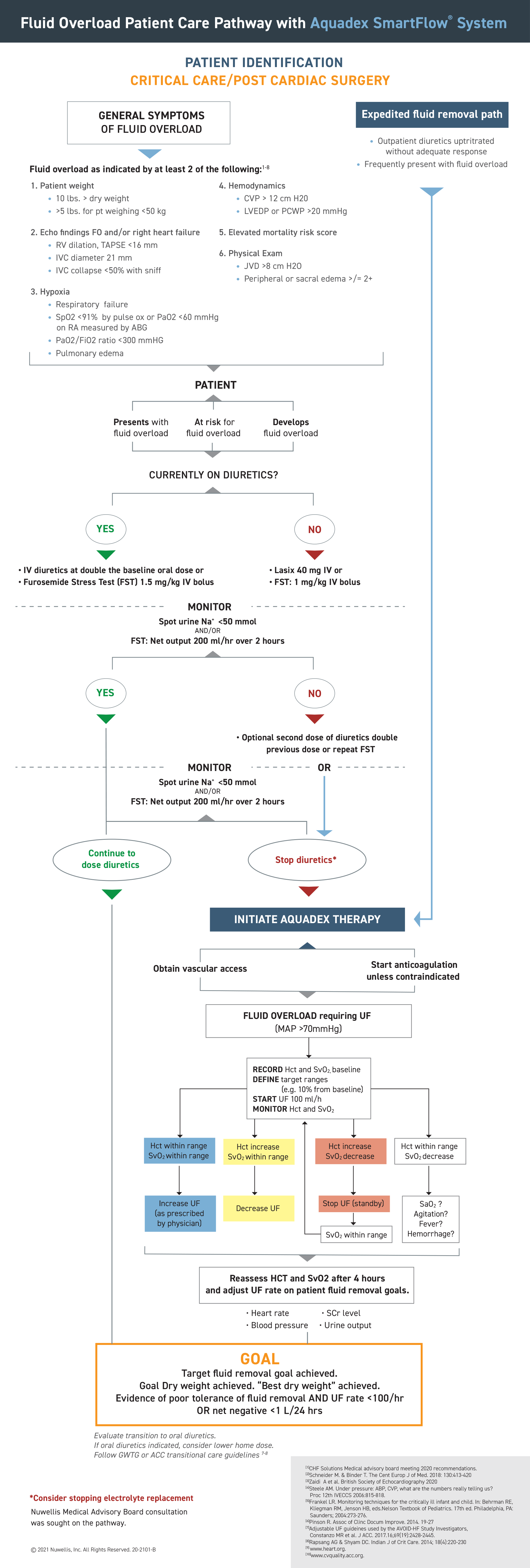Managing Critical
Care Patients
A STEP TOWARD PREDICTABLE AND PRECISE REMOVAL
MANAGING FLUID OVERLOAD IN POST SURGICAL PATIENTS
Providers, like you, face the daily challenge of managing fluid in post-op cardiovascular (CV) surgical patients. The Aquadex SmartFlow® System allows for predictable and precise fluid removal with no clinically significant changes to electrolytes.
THE CHALLENGE WITH FLUID OVERLOAD
- Nearly 1 of 5 patients who undergo cardiac operations require readmission1
- In a multi-center study, volume overload was among the top 3 most prevalent causes for first readmission within 30 days and beyond 30 days1
- 40% of patients cannot eliminate excess fluids post-surgery due to Acute Kidney Injury2
- Fluid overload is associated with a 300% increase in 90-day mortality rates post-op cardiac surgery3
PREDICTABLE OUTCOMES WITH AQUADEX
- Modified ultrafiltration reduces the duration of assisted ventilation post-op cardiac surgery1,4,5
- Ultrafiltration improves cardiac performance1,6,7,8
- Ultrafiltration following cardiac surgery may reduce the need for blood transfusions6,9,10,11
FLUID OVERLOAD MANAGEMENT WITH AQUADEX
The workflow for managing fluid overload in post-op CV surgical patients is not intended to replace the Aquadex SmartFlow Direction For Use (DFU). Always follow the appropriate and applicable local, institutional, and/or hospital policies, procedures, and requirements.

COST OF TREATING CRITICAL CARE PATIENTS
Nearly 1 in 5 patients who undergo cardiac operations require readmission and fluid overload is among the Top 3 most common causes within 30 days and beyond 30 days.1
500,000 Cardiac Surgeries
in the US12-14
40% of patients cannot eliminate excess fluids post-surgery due to Acute Kidney Injury2
US Cardiac Surgery Readmissions
1 in 5 require readmission and fluid overload is a Top 3 reason1
ECONOMIC BENEFITS OF AQUADEX
- Reduced HF admissions and readmissions15
- Reduce average HF readmission lengths of stay15
- Shorter HF index lengths of stay vs. standard pharmacological therapy16
- Reduction in duration on assisted ventilation in CV surgery patients7-9
CLICK AN INDICATION TO EXPLORE THE IMPACT OF AQUADEX
[1] Iribarne A, et al. Ann Thorac Surg. 2014 Oct; 98(4): 1274-80. [2] Ann Thorac Surg. 2011; 92-1539-47. [3] Pradeep, A. et al. HSR Proc IC and Car An. 2010 Mar; 2(4): 287-296. [4] Crawford, T et al. Ann Thorac Surg. 2017;103:32-40. [5] Mariscalco, G et al. Ann Thorac Surg. 2011;92:1539-47. [6] Stein, A et al. Critical Care. 2012;16:R99. [7] Luciani GB, et al. Circulation. 2001 Sep 18;104(12 Suppl 1):1253-1259. [8] Kiziltepe U, et al. Ann Thorac Surg. 2001 Feb;71(2):684-93. [9] Grunenfelder et al. Eur J of Cardio Thoracic Surgery. 2000;17:77-83. [10] Sahoo TK, et al. Indian J Thorac Cardiovas Surg. 2007 Jun;23(2):116-124. [11] Boga et al. Perfusion. 2000;15:143-150. [12] https://idataresearch.com/new-study-shows-approximately-340000-cabg-procedures-per-year-in-the-united-states/. [13] https://idataresearch.com/over-182000-heart-valve-replacements-per-year-in-the-united-states/. [14] https://www.mdedge.com/chestphysician/article/148584/heart-failure/lvad-use-soars-elderly-americans. [15] Costanzo MR, et al. J Med Econ. 2019, VOL. 22, NO. 6, 577–583. [16] Costanzo MR, et al. J of Am Coll Cardiol. 2005;46(11):2047-2051

